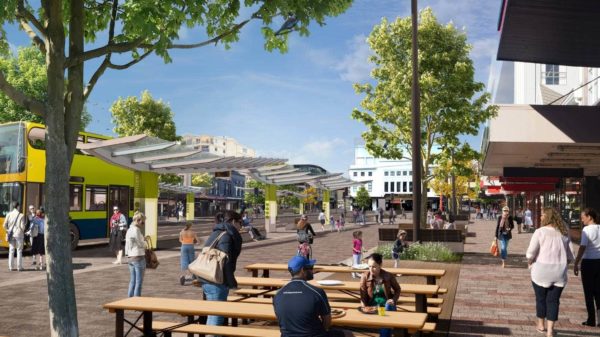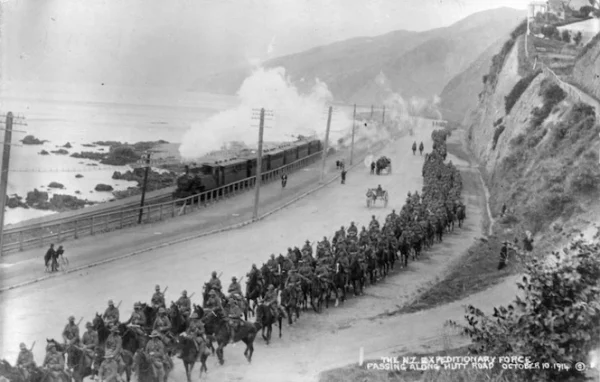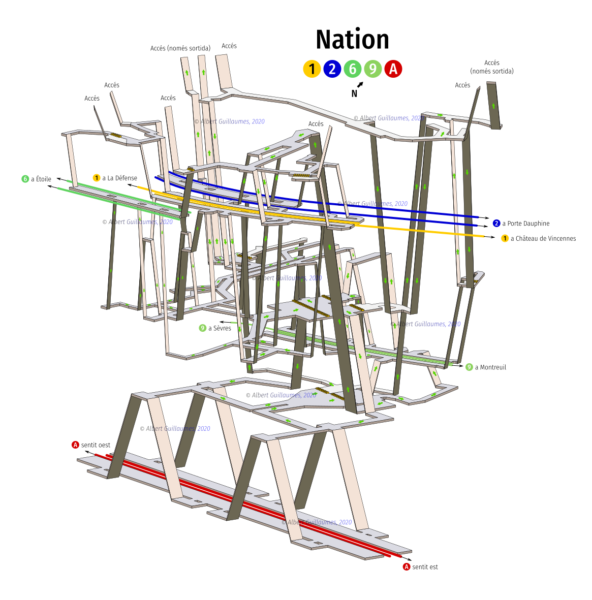Tēnā koutou and welcome to the first weekly roundup of August/Here-turi-kōkā.
Cover image: Auckland’s newest TBM gets sent underground in style.
The week in Greater Auckland
Monday’s post broke down the VKT reduction targets in the Emissions Reduction Plan.
On Tuesday, Scott shared a Coalition for More Homes letter asking Council why planning for [underground] Light Rail appears to be getting in the way of denser housing where it’s needed on the Isthmus.
Wednesday’s post, by Matt, explored a new transport policy from Mayoral candidate Viv Beck: opening the tunnels under Albert Park.
Yesterday, we had a guest post by Peter N, about why the extra protection going in on bike lanes like Upper Harbour is so important.
Enrol to vote by the 12th of August! (and vote for the climate)
Are you enrolled to vote? Local elections are approaching quickly now, and you need to be enrolled by the 12th of August – that’s next Friday! You can enrol, check, change and update your details here.
Also, Greater Auckland is an official supporter of Vote Climate, a group advocating for climate action to be a central topic at this year’s local elections. Your vote can call for climate action in this local election.
Say hello to Auckland’s newest Tunnel Boring Machine
… and it’s got the best name yet. TBM Princess Twilight Super Worm was named and decorated by tamariki from New Lynn Kindergarten.
Princess Twilight Super Worm is about to start her work on the Clinker and Ambrico Place stormwater improvement project, tunnelling a distance of 550m underground from Rankin Avenue, New Lynn to an outfall in Manawa Wetland Reserve over the next eight months.
There’s something wonderful about knowing that Princess Twilight is going to be churning along beneath our feet for the rest of the year.

Locked out of the housing debate
‘Pretty cooked’ is how one local board candidate described an anti-intensification meeting at St Matthews in the City last weekend. Dileepa Fonseka reported on the meeting, at which organisers appeared to be trying to prevent young people from entering because they might be pro-intensification.
Fonseka dives into the reasons for our current housing squeeze and why so many of the arguments against intensification just don’t stack up.
Between 1938 and 1977 a 1% rise in population led to a 0.5% increase lift in house prices, yet between 1977 and 2018 that same increase caused a price bump four times that rate.
As the Infrastructure Commission concluded, stricter development rules came into play between 1977 and 2018, which affected the ability of builders to increase house-building to keep up with population growth.
Widened footpaths creating space for people on Queen Street
You can’t help but wonder – all those dire articles pronouncing the death of Queen Street a month or so ago – were they perhaps just visiting on a rainy day? The sun was out this week, and so were the people.
Alec Tang captured pedestrians spreading out into new, more generous footpath space on Lower Queen Street this week.
funny how when you build wider streets, there’s more space for people.
who’d have thunk?! pic.twitter.com/kot3EogvOA— Alec Tang 鄧振揚 (@AlecTang_) August 4, 2022
Pedestrianising Wellington’s golden mile will be gold for businesses
A research report by Ernst and Young has found that pedestrianising the Golden Mile will benefit businesses, with more pedestrians bringing higher sales volumes. The report looked at 12 case studies, including some Auckland examples.
Greater Wellington regional councillor Roger Blakeley said international and local evidence had shown businesses would benefit from pedestrianisation.
Blakeley was chief planning officer at Auckland City Council between 2010 and 2015, when Fort St was pedestrianised. A later study by Auckland City Council showed its pedestrian numbers increased by 47% during peak hours, retail spend increased by 47% and hospitality spend by 429% .
“The businesses, just like in Wellington, were concerned this would be the kiss of death,” he said. “In fact, what happened was the reverse of that.”

Pōneke cycleways, past and future
Wellingtonians debate the Thorndon bike lane
Can we preface this with a …yawn? This article on Stuff about residents reactions to the proposed Botanic Garden ki Paekākā to city cycleway hits all the right notes in our ‘opposition to bike lanes’ bingo card.
But, there’s some really encouraging responses too, from a few people who really get it.
Northland resident Dylan Cliff, who walks that route to catch the train, said that was the whole point. The only way to get people onto bikes and other more sustainable options was to make driving more difficult.
“There’s no reason to have a [time-dependent] clearway except to try and claw back a little bit of parking for these businesses who, primarily – as lots of research has shown – get more money and have more attendance from people who are cycling and walking,” he said.
Remembering the Wellington-to-Petone cycleway that once was
Last week, Matt wrote about cost overruns on the proposed Ngauranga to Petone cycleway seawall, and this week, an incredible photograph of a wide path along the same road appeared on our feeds. Shared by Michael Brown on Twitter, it shows a traffic-lane sized walking and cycling path on the inside of the train line – yet another example of space that people were forced to relinquish to cars.

Hey Wellington – how’s this for windy?
This is possibly an option for the Ngāuranga to Petone cycleway seawall once it’s complete.
Each year, on the windiest day of the year, the Dutch Headwind Cycling Championships take place on the Oosterscheldekering Storm Surge Barrier.
Over 200 competitors ride the 8.5 km course against 100+ km/hr winds on upright single-speed bikes. Watch more: https://t.co/h2sVb6819T pic.twitter.com/SG4Sv2zs5y
— Dutch Cycling Embassy (@Cycling_Embassy) August 1, 2022
Getting traffic deaths to zero
Hoboken, New Jersey, might seem like an unlikely road safety success story – but there hasn’t been a traffic death there in four years. In this brief interview on NPR, Hoboken’s Director of Transportation and Parking explains how simple infrastructure has led to culture change in the city.
… in Hoboken, an incremental approach over several years that includes more than just engineering, but also education and a focus on changing the culture. The simple improvements like daylighting or leading pedestrian intervals or adding curb extensions, these things are still in place, and they’ve been having a positive impact. And people have gotten used to seeing these things in town, and they ask for more.
The week in flooding, and other climate emergency related weather events in the USA…
A ‘pretty active monsoon season’ sent summer thunderstorms cascading across the desert-like southwestern part of the USA this week.
In northern Arizona, Flagstaff residents have grown accustomed to constant alerts on cellphones and sirens in neighbourhoods warning of imminent flooding.
Bret Henneman estimates he has about 3500 sandbags around his home just north of Flagstaff where two wildfires burned this spring. His wife was babysitting and had the back door open two weeks ago when heavy rain fell and sent a minimum of 50mm of rain and mud through the home.
In Kentucky, terrifying floods have displaced whole communities and hundreds of people are missing, and many areas are still completely cut off.
The White House’s response was clear about the role of climate change in the disaster.In a statement, the White House said: “We know that the impacts of the climate crisis are here, and that we must invest in building resilience to protect our communities, infrastructure and economy.”
Meanwhile, the snowpack on the Western Sierra is shrinking, threatening the stability of the west coast states. Seasonal snowmelt from the Sierra is a key source of water for the California basin for agriculture and power.
In the US West, Rocky Mountain snowmelt has dropped so much that the massive reservoirs along the Colorado River are in danger of no longer being able to produce power at their hydroelectric dams — something that’s never happened before — much less supply all the water needed by the seven states that rely on them.
See Submerged Portraits on Queens Wharf
Head down to Queens Wharf to see a powerful series of photographs by Gideon Mendel of people whose homes have been hit by major floods. Mendel has been making photographs about climate change since 2007, and has noticed a change in the way we talk about it.
“There’s often a lot of blame and anger. Many, many of them certainly see themselves as being victims of climate change.”
Since he started in 2007, the discourse over climate change has evolved, he said. He had young children at the time, and he tried to imagine what the world might be like when they were older.
“At that point – I think this has changed, but at that point there was a real lack of images which showed the human dimension.

Ryanair, coming to a train station near you?
… but these shinkansen passengers probably aren’t the target market for a budget rail journey.
They look like they’d prefer a little more luxury.
Dear you,
Thought you might be having a bad day, so I figured you'd better see this Kitty-Shinkansen.
All the best,
Taras pic.twitter.com/WRgouBJHmw— Taras Grescoe (@grescoe) August 2, 2022
A seriously deep study of train stations
It’s hard to describe the scale of work that went into this engineer’s passion project: Albert Guillames Marcer has modeled 625 train stations (mostly in Europe) in 3D, just so he could understand them better.
For the last 10 years I have been able to draw around 625 stations from different European cities, motivated by the curiosity of understanding how engineers were able to fit underground stations comprising 4 or 5 lines under Place de la République in Paris or the Puerta del Sol in Madrid.
A pen, a notebook, a bit of spatial vision and the willingness to navigate all the staircases, corridors, platforms and mezzanines are enough to draw a station. Some may content errors, despite I try to complement them with information found in the internet: historic, construction and survey maps, pics and videos, as well with data about train lengths.
VKT down by 23% in Belgium since 2019
In news that can’t be attributed to COVID-19 alone, people are driving less in Belgium. The trend is particularly strong in the 18-34 age group, who now do less than half of all their travel by car. Interestingly, fewer car trips seem to be turning into more walking and cycling trips, rather than public transport – although that probably is related somewhat to the pandemic.
In addition, the share of pedestrians has increased significantly with 12.01% of kilometers traveled in Brussels during the first half of 2022, compared to 7.17% in 2017. Regarding bicycles , use is also increasing with a share of 6,47% (including 1.94% for electric bicycles) in 2022, whereas this share was only 1.56% five years ago.
(translated from French using Google Translate.)
On falling out of love with your car
We definitely related to this piece on the Financial Times, in which the author relates the experience of realising how much of a burden her car had become.
As Bryan Appleyard notes in his recent book The Car, US driving culture has been the endless pursuit of a mythical place: “There is a popular conviction, first, that America in particular is a country that needs looking for and, second, that it cannot be found.” The same I think might be said of the promise of a motor vehicle as freedom: from fast roads and cruise control to autonomous driving, it is an endless promise on the horizon of some full liberation, one that you never reach.
It turns out EV rebates are inequitable
We’ve been thinking about this one for a little while. EV rebates have done a good job of kick-starting the shift away from fossil-fuel private cars. But the more we look at it, the narrower this solution starts to seem. What about all of the other low carbon forms of transport that should be incentivised?
An Irish study looking at EV uptake has found that the beneficiaries of Ireland’s rebate scheme have predominantly been middle- and high-income urban people.
The results indicate that 1) urban areas are more likely to see higher concentrations of EV ownership, 2) an income and equity gap exists between those that have adapted electric mobility. This finding is very important because it suggests that lower income categories may have a financial barrier to shifting to EVs.
Furthermore, perhaps the USA needs to focus on smaller electric vehicles.
This stat surprised me: on avg, two US electric vehicles use as much electricity per year as a US household. Much more efficient than ICEs, but nevertheless, we're going to need a whole lot of clean electricity.
— Tyler Norris (@tylerhnorris) August 1, 2022
But how about ebike rebates?
Ebike sales continue to dramatically outpace electric vehicle sales in Europe.
1/ I made this chart comparing #ebike and #EV sales for Europe – it's quite striking. Seems like a big deal and no one talks about it pic.twitter.com/I6no0NRWv6
— Olaf Sakkers (@osakkers) July 29, 2022
Discounts on ebikes in Denver
A rebate scheme for ebikes opened in Denver this month, and it was so popular that it overwhelmed the system.
Today's line to get an E-bike through the Denver rebate program. Glad to know people are willing to commute more sustainably. pic.twitter.com/B0C3VO8Ett
— donnie (@donna34699371) July 28, 2022
Meanwhile in Aotearoa
Even without rebates and assistance, imports of ‘electric micro transport’ (e-bikes, e-scooters, e-mopeds) quietly overtook acoustic bikes in the last year. As Stats NZ reported back in May:
Alternative forms of personal transport are also important in the reduction of New Zealand’s transport emissions. While the humble pedal-powered bike has remained popular for over a century, the electric mode shift has touched this growing sector too. Electric micro-transport imports (from e-mopeds and e-bikes to e-scooters) have steadily increased since 2017, reaching $112 million in the year to March 2022, and overtaking the value of mechanical bicycles in 2021.

The New Yorker covers biking
"I love biking in the city because you can go wherever you want. You don’t have to wait for the subway or be stuck in traffic." https://t.co/Uey9tknzf1 pic.twitter.com/Y2EZBMnTFp
— The War on Cars (@TheWarOnCars) August 1, 2022
Reallocating streets to forests
This takes Urban Ngahere to a whole new level: beautiful, forest-like parklets have popped up in Toronto this summer, in former parking spaces.
Turns out induced demand works for public green spaces too. If you build them, people will fill them immediately.
Hard to believe these people are lounging on what used to be a parking space. pic.twitter.com/YeoT9Ktwxj
— Jake Tobin Garrett (@jaketobin) July 1, 2022
Catching the fog
Yesterday was a particularly spectacular example of an Auckland winter fog, captured in timelapse here by NIWA.
https://twitter.com/NiwaWeather/status/1554956043540905984?s=20&t=tzCxgaFwq-7Mx0sj2RUphQ
A tērā wiki – see you next week.




 Processing...
Processing...
Heard on RNZ,this morning,motorist bemoaning the fact that Wellington morning commute had been greatly extended time wise by slips closing roads,no plans to fix ,until ground stabilises/dries out a bit. Went to great lengths to make a point about increased CO2,from all the increased idling.
I wonder when the penny might drop for said commuter,and an alternative might be considered.
Here’s a stupid nerd question: Is there any law that requires us to review our project management costings once we finish something?
“Pedestrianisation of Wellington’s Golden Mile” is a misnomer. The full, spinal, still-mainly-diesel bus service is still intended to run down it. During peak hours this translates to a bus every 40-50 seconds each way, otherwise known as two endless streams. And population-growth projections plus mode-shift aspirations may see the number of buses doubling. If at some future date light rail or BRT is installed via a different route then bus intensity on the Golden Mile may reduce, but construction of any sort of Mass rapid Transit is not expected to start until 2028 and then will take 8-15 years to complete. It will be interesting to see how things play out in reality.
Lots of new three story units along the proposed light rail route through Mangere so there won’t be an oportunity for six storey apartment blocks because all the suitable land will be used up.
I notice that the paver on the new widened footpaths along Queen Street, have been laid with a very distinct side slope, making walking on them very difficult. Is this a design feature??
hey Bus Driver. not involved in the scheme but suggest it will be a consequence of three factors:
a. keeping the existing camber of the road, as it’s an interim scheme so bigger works would be way too expensive and take much too long,
b. someone decided kerb heights had to be retained similar to elsewhere on the street; slightly against good street design which would call for minimal or even no kerbs (with ongoing debates globally around how suitable that is for visually impaired people), and
c. using a consistent type of pavers which have the same thickness / depth across the scheme, again for budgetary / simplicity reasons
A more permanent scheme would likely involve full reconstruction of the street, hopefully ensuring a more comfortable and accessible user experience.
Interesting stuff as always.
Greater Auckland’s posts this week highlight crucial topics like VKT reduction, housing density, and bike lane protection. Stay informed and vote!